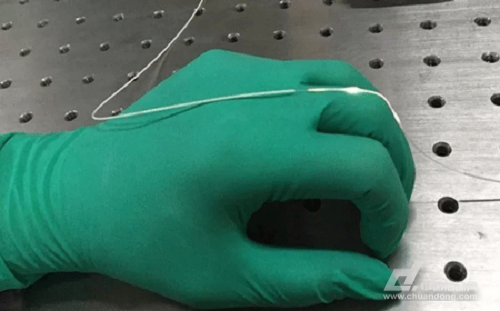With the growing popularity of wearable technology, the need for advanced wearable sensors is on the rise. These sensors can be attached to the body or embedded in clothing, enabling athletes to track their movements more effectively, helping physical therapists assist patients in recovery, and even enhancing motion capture for video games and animation. Additionally, they can aid engineers in developing robots capable of gentle touch or contribute to real-time health monitoring systems.

Accurately capturing human movement is a complex task. The human body—hands, feet, facial expressions, and other parts—can bend and deform in intricate ways. While electronic strain sensors are widely used, they often face limitations due to external electromagnetic interference. This is where optical fiber sensors come into play, offering an alternative that is immune to such interference.
Optical fiber sensors have been around for a long time and are commonly used in structural monitoring, like measuring bridges and buildings. When a fiber bends, light passing through it changes, and these changes can be measured and translated into data about forces acting on structures. However, traditional optical fibers made from glass or brittle plastics are not ideal for wearable applications, as they can break under even slight deformation.
A team led by Changxi Yang at Tsinghua University’s State Key Laboratory of Precision Measurement Technology and Instruments recently published a groundbreaking study in *Optica*, introducing an elastic fiber capable of sensing a wide range of human motion. This new fiber is both sensitive and flexible, allowing it to detect joint movements in a way that current optical fibers cannot.
Yang explained, “This technology offers a new method for measuring large deformations using fiber optics. It is wearable, easy to install, and retains the inherent advantages of optical fibers, such as electrical safety and immunity to electromagnetic interference.â€
One of the main challenges with traditional optical fibers is their rigidity. Made from hard materials like glass or plastic, they are not suitable for the complex movements of the human body. For example, silica-based fibers can only withstand about 1% strain, while finger joints can stretch beyond 30%, making them unsuitable for wearable use.
As a result, most wearable sensors today rely on electronic systems that measure changes in electrical properties, such as resistance when bent. However, these systems are difficult to miniaturize, prone to losing charge, and vulnerable to electromagnetic interference from devices like smartphones and cars.
Flexible fibers, on the other hand, offer a more stable and sustainable solution. Researchers explored various materials to find one that could handle stretching and bending without breaking. They first tested hydrogels, which can stretch up to 700%, but they dried out quickly when exposed to air, limiting their practical use.
In their next attempt, Yang and his team developed a fiber made from polydimethylsiloxane (PDMS), a soft silicone polymer. By heating liquid silicone in a mold and using water pressure to shape the fiber, they created a material that could stretch multiple times without losing its original length. Even after 500 stretches, the PDMS fiber returned to its original form.
To make the fiber functional as an optical sensor, the researchers added a fluorescent dye called rhodamine B into the silica gel. As light travels through the fiber, some is absorbed by the dye, and the amount absorbed depends on how much the fiber is stretched or bent. This allows the sensor to accurately reflect body movements.
To test the fiber's performance, the team attached it to a rubber glove and had a person move their fingers. The results showed a strain of 36%, matching measurements from electronic sensors. The fiber also performed well in detecting subtle movements, such as those caused by breathing or speaking.
Overall, this research demonstrates that optical fiber sensors can effectively monitor a wide range of human motions, opening up new possibilities for human-machine interfaces and wearable technology.
Power Plant
Disel and gas power plant with high volatge diesel generators, Gas Generator, power plant management system
·Engine and alternator shall be mounted on a same frame steel skid.
·World most famous brand diesel engine: Cummins, Perkins, MTU, CRRC, CSSC, CSI
·World famous brand High Voltage AC alternator: Stamford, Leroy Somer, Marathon, Faraday, etc
·Advanced and reliable controller: Auto start, AMF & Remote control by PC with RS232/485
·Full range protect function and alarm shutdown feature.
·Comply with ISO8528 national standard and ISO9001 quality standard.
. Voltage: 3kV, 3.3kV, 6kV, 6.3kV, 6.6kV, 10kV, 10.5kV, 11kV,13.8kV
Power Plant,Gas Power Plant,Diesel Power Plant,Lighting Tower
Guangdong Superwatt Power Equipment Co., Ltd , https://www.swtgenset.com